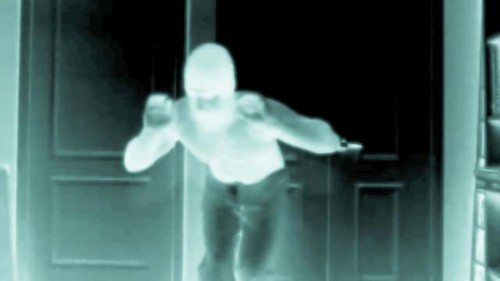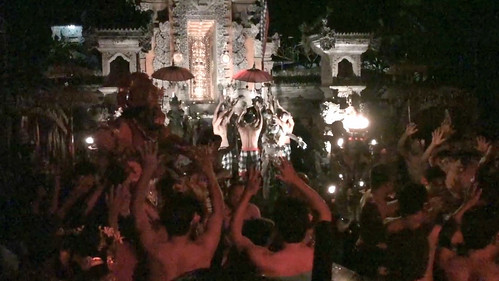(Photograph by Gustavo Thomas. 2009)
Kecak (called also Cak) is one of the best known Balinese Performing Arts, a mix between a religious choral piece, a theatre play and a choreographed dance, based on a choir of local men. It is not an old form, it was created from some ancient Sanghyang (trance) forms during the 1930s, adding a theatrical story. Some give the credit to German visitor Walter Spies, while others give it to two Balinese masters, I Gusti Lanang Oka and I Nengah Murdaya.
Miguel Covarrubias (who was there around 1930) didn't know about Kecak, but did know about Sanghyang and the use of the word "kecak" in its chants as an accompaniment of the trance dance. Kecak developed into a theatrical form when it was separated of the trance and stories, wether from the Ramayana or from other Hindu epics, added to it.
Even when Kecak is the theatrical form without trance, its performance is completed with a short trance piece, the "Sanghyang Djaran" or Trance Dance of the Horse, a piece about which I'm going to talk about in the next post of these Bali performing arts series.
(Photograph by Gustavo Thomas. 2009)
To talk about the rhythms in Kecak I'm quoting the book "Balinese Dance, Drama and Music"(1):
"The polyrhythmic vocal chanting that makes up most of the performance is sung in interlocking parts. Most chorus members know at least four different rhythmic patterns: syncopated cak telu (three syllables), cak lima (five), cak nem (six) and the simple non-syncopated pattern cak ocel (three and seven syllables). There is also improvised panyelah (five syllables). Syncopated rhythms require three voices: polos (down beat), sangsih (upbeat) and sanglot (in between). The interlocking patterns of three and six strokes are chanted within one gong cycle and are marked in the melody by a gong-like sound, sirrrrr. The five-stroke and non-syncopated pattern are freer. All patterns are laid over the kajar and the melody. The kajar is the time-keeping gong, vocalized in Kecak with a pung sound. The melody is chanted as yanger yangur yanger yanger yang sir."
What I saw that night at Pura Dalem Taman Kaja in Ubud was a performance by Taman Kaja Community. Most of the members of that group, as its name says, were from the same neighbour (called Desa), in this case Desa Pakraman Taman Kaja.
That was a powerful and energetic performance, full of life and interesting images, visual and vocal images. Yes, the voice of those a hundred men chanting is still in my memory today, their sound provoked to my whole body a vibration difficult to forget. It was a very unique experience watching this also very unique theatrical form.
Luckily I was able to record almost the whole performance, so you can see photographs and video of it. You have to understand that night it was raining and the visibility was poor, plus my seat was very close to the stage.
Program of Kecak performance at Pura Dalem Taman Kaja, Ubud (2009)
This is what the program says about the story to see (original redaction):
The story is a fragment from the Ramayana, the hindu epic. (...)
Prince Rama, heir to the throne of the kingdom of Ayodya, and his wife Sita have been banished from the kingdom by King Dasarata as a result of trickery by Rama's stepmother. The story begins with the arrival of Rama and Sita accompanied by Rama's brother Laksmana in the forest of Dandaka.
The trio have been observed by the demon Rajwana, King of Alengka, who lusts after the beautiful Sita. Rahwana sends his prime minister Marica to try to isolate Sita so that Rahwana can kidnap her. Marica's magical powers turn him into a golden deer and he enters the forest and when Sita sees the golden deer she is so enchanted by it that she asks Rama to capture it for her. Rama chases after the deer leaving his brother Laksmana behind with strict instructions to protect Sita. When Sita thinks she hears a cry for help from Rama she forces Lasmana to go after Rama by accusing him of cowardice and he goes off to help Rama with great reluctance after drawing a magic circle on the ground and telling Sita that she should not under any circumstance step outside the circle.
Sita, left alone in the forest becomes an easy prey to the trickery of Rahwana who has disguised himself as an old priest and begs Sita for some food as he is cold and hungry. Sita falls for his trick, she steps outside the circle to give the old priest some food and Rahwana grabs her and takes her to his palace.
Once back in his palace in Alengka Rahwana tries everything he can to seduce Sita without any luck.
In the meantime Hanoman, the white monkey, a good friend of Rama, is searching everywhere for Sita.
In the palace of Alengka Sita pours out her heart about her cruel fate to Rahwana's niece Trijata, who had come to love Sita, when Hanoman appears telling her that he is Rama's envoy and proving it by showing her Rama's ring. Sita gives Hanoman a hairpin to show that she is still alive and sends him back to Rama with a message to come to her rescue.
In the meantime Rama and Laksmana are wandering in the forest looking for Sita when Meganada, Rahwana's son, appears and engages Rama and Laksmana in battle. Meganada uses his magic powers and shoots of an arrow which magically turns into a dragon which overpowers rama and Laksmana and they are trussed up in ropes.
The bird Garuda, King of all the birds, a good friend of King Dasarata, has observed the trouble Rama is in from high up in the sky and comes to the rescue freeing hte brothers from the ropes.
Rama and Laksmana continue on their way to rescue Sita and are joined by Sugriwa, King of the monkeys, and his monkey army.
This fragment of the Ramayana comes to an end with the battle between Sugriwa and his monkey army and Meganada and his demon army which ends with the defeat of Meganada.
Kecak Performance at Pura Dalem Taman Kaja, Bali (2009) from
Gustavo Thomas on
Vimeo.
(1) Balinese Dance, Drama and Music. By I Wayan Dibia and Rucina Ballinger. Periplus Editions, Singapore, 2004.
Texts, photographs and videos in this Blog are all author's property, except when marked. All rights reserved by Gustavo Thomas. If you have any interest in using any text, photograph or video from this Blog, for commercial use or not, please contact Gustavo Thomas at gustavothomastheatre@gmail.com.











